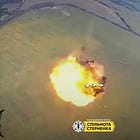Videos Document Use Of Ukraine's F-16 Fighters To Intercept Strike Drones, Cruise Missiles
🇷🇺 🇺🇦 Analysis
A new video documents the interception of a Russian Shahed-136/Geran-2/Gerbera propeller-driven fixed-wing strike drone by a Ukrainian F-16 fighter jet. This video is notable in that it documents the use of the F-16’s M61 rotary cannon.
The Ukrainian Air Force also recently released a video documenting the launch of AIM-9 infrared-seeker-equipped short-range air-to-air missiles from its F-16 fighters to intercept either propeller-driven fixed-wing strike drones or cruise missiles. It bears emphasis that the Ukrainian Air Force released the longer video from which the following was trimmed alongside a press release claiming that its F-16 fleet had intercepted most of the cruise missiles that Russia had launched overnight.
While the use of the M61 rotary cannon in the first video likely made for a memorable experience for observers on the ground, it is in many respects a high-risk and, more importantly, an uneconomical undertaking. Given the closing velocity, the pilot of any fighter aircraft attempting to shoot down the likes of a Shahed-136/Geran-2/Garpiya propeller-driven fixed-wing strike drone runs the risk of rapidly flying into the cloud of debris generated by a successful interception. The fundamental problem with gun-type armament is limited range. Air-to-air missiles such as the AIM-9 are, when viewed in isolation, incomparably more expensive, but can be launched from a safe distance—semi-active laser homing air-to-ground turned air-to-air missiles like the American AGR-20 FALCO are far less capable than the likes of the AIM-9 but also around 90% less expensive.
Another problem associated with using gun-type armament in air-to-air interceptions is that contemporary fighter aircraft carry very limited ammunition for their extremely high rate of fire gun-type armament. The F-16, for example, is limited to carrying around 500 rounds of 20×102 mm ammunition for its six-barrel M61 rotary cannon, which has a maximum rate of fire of around 6,000 rounds per minute. Simply stated, contemporary fighter aircraft can undertake very few interception attempts with gun-type armament before running out of ammunition. While wing or fuselage-mounted gun pods are an option for some contemporary fighter aircraft, the onboard ammunition supply is still limited, and no amount of ammunition can mitigate the risks posed by the interplay of closing velocities with the very short range of gun-type armament.
While air-to-air missiles such as the AIM-9 do not have the aforementioned limitations of gun-type armament, these are far more expensive and, no less importantly, each F-16 can only carry up to six AIM-9 air-to-air missiles per sortie. Other contemporary fighter aircraft have similar maximum loadout figures. At the same time, air-to-air missiles such as the AIM-9 are one-shot, one-kill type munitions against the likes of the fairly large fixed-wing propeller-driven strike drones like the Shahed-136/Geran-2/Garpiya, as well as cruise missiles more generally. Any sound analysis must assign the appropriate weight to this attribute, one that essentially means that each F-16 equipped with six AIM-9 air-to-air missiles has a realistic prospect of successfully intercepting six (non-evasive) aerial targets.
In this and so many other aspects of the Russia-Ukraine War, observers run the risk of comparing the unit costs of munitions without undertaking a holistic accounting. The likes of 20×102 mm ammunition—whether fired from a M61 rotary cannon mounted on an F-16 or a M61 rotary cannon mounted on a truck—will always be less expensive than any guided, anti-aircraft munition equipped with a solid-propellant rocket motor. It is, however, ill-advised to forgo the use of air-to-air missiles, whether a quite sophisticated design like the AIM-9 or a comparatively rudimentary AGR-20 FALCO, in aerial interceptions on the basis of unit cost comparisons. Interceptions involving the use of gun-type ammunition take more time, and all fighter aircraft cost thousands of dollars to operate per flight hour. Fighter aircraft also cost tens of millions of dollars to acquire, and the acquisition cost is, in practice, amortized per flight hour. A very brief fifty-round burst from an autocannon can cost something in the region of US$500-$1000, if not more. While this is a very low cost per intercept (attempt) when compared to around US$500,000 for the likes of the AIM-9 and around US$50,000 for the likes of the AGR-20, the aircraft being flown, its post-flight servicing and repairs, and its fuel are not free. A holistic accounting of cost effectiveness in air defence cannot be reduced to the unit cost of ammunition x vs ammunition y. All things considered, militaries are buying capability and, in an important sense, paying to save time. While decision-makers and observers are susceptible to stickshock, money spent is sometimes money saved.
Some related posts:




